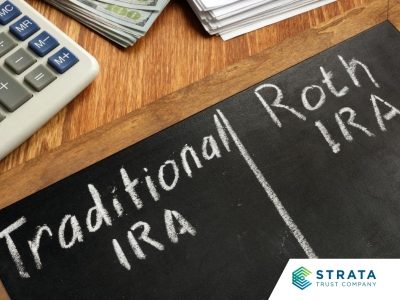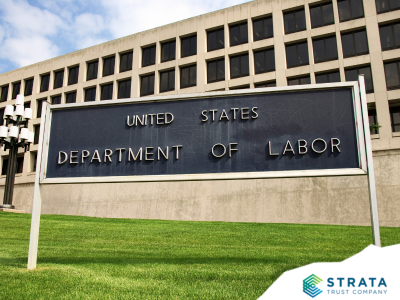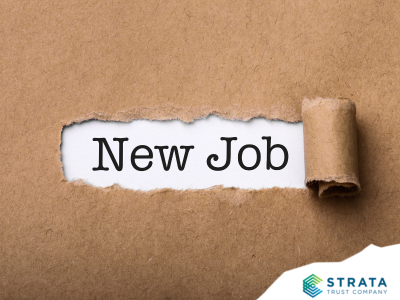If you are thinking about making a job change, you’re not alone. According to the Willis Towers Watson’s 2022 Global Benefits Attitudes Survey, 44% of employees are currently actively looking for a job with a different company. The COVID-19 pandemic has prompted a seismic shift in the workplace and employee sentiment, as they reevaluate their priorities particularly surrounding work/life balance. In fact, in the last 10 months of 2021, more employees left their jobs than ever before. According to the Bureau of Labor Statistics’ Job Openings and Turnover Report from March 2022, the number of workers that quit their jobs in the previous month exceeded 4.4 million and there are no signs of this slowing down.
This era of career changes has been coined “The Great Resignation,” and although it is great for workers to be prioritizing their needs in the workplace, there is much to be considered when changing jobs – one facet in particular is retirement. There are common mistakes among individuals changing jobs that can be avoided with proper planning. Here’s what job seekers need to know.
Mistake #1: You Have Multiple 401(k)s in Different Locations
 How to solve it: When leaving your job, the first consideration is the 401(k) that you hold with your previous employer. At best, you are relying on your former plan sponsor to successfully hold your hard-earned retirement savings. At worst, you could forget about old accounts and lose out on all of the money you’ve accumulated. According to one estimate, there are 24.3 million forgotten 401(k)s out there, holding $1.35 trillion worth of assets in them.
How to solve it: When leaving your job, the first consideration is the 401(k) that you hold with your previous employer. At best, you are relying on your former plan sponsor to successfully hold your hard-earned retirement savings. At worst, you could forget about old accounts and lose out on all of the money you’ve accumulated. According to one estimate, there are 24.3 million forgotten 401(k)s out there, holding $1.35 trillion worth of assets in them.
If you have a balance lower than $1,000 in your 401(k), your employer may decide to write you a check and close your account. Alternatively, you can rollover your balance into your new employer’s plan or an IRA. Both of these situations have tax implications that need to be navigated. For example, when rolling your balance over, doing a direct rollover will save you from paying 20% in taxes.
Rolling your funds into an IRA is a great option for most people. Consolidation makes managing your portfolio and keeping track of your accounts easier and ensures that no accounts will be forgotten about. Another benefit of consolidation is that each 401(k) plan has its own policies, and it can become very difficult to keep these straight when balancing multiple accounts. Additionally, advisors typically recommend rebalancing your retirement allocations on a yearly basis. When all of your eggs are in one basket, it becomes easier to do this.
When deciding what route is best for you, be sure to consider the time restrictions. It is important to make a move with your 401(k) before your previous employer does—or before you forget about your 401(k) altogether.
Mistake #2: You Are Focused Only on Your Company’s 401(k) Without Reviewing All Your Retirement Options
 How to solve it: Changing companies could be a great time to reconsider your overall retirement planning strategy. Instead of relying solely on your new company’s employer-sponsored account, consider a Traditional or Roth IRA. Another common theme amid The Great Resignation is workers leaving their jobs to start their own business. According to the Census Bureau, a record 5.4 million new business applications were submitted in 2021. For those starting their own businesses, there are even more options available such as a SEP or SIMPLE IRA to look into.
How to solve it: Changing companies could be a great time to reconsider your overall retirement planning strategy. Instead of relying solely on your new company’s employer-sponsored account, consider a Traditional or Roth IRA. Another common theme amid The Great Resignation is workers leaving their jobs to start their own business. According to the Census Bureau, a record 5.4 million new business applications were submitted in 2021. For those starting their own businesses, there are even more options available such as a SEP or SIMPLE IRA to look into.
Supplementing your 401(k) with a Roth or Traditional IRA could be a very beneficial move from both a savings and a tax standpoint. These accounts not only give you the opportunity to save more but offer a greater variety of investment options as well. There are also potential tax benefits, based on the plan type you select. Contributions made to 401(k) accounts are pre-tax, meaning you don’t pay taxes on the savings until you make a withdrawal in retirement. Conversely, contributions to a Roth IRA are taxed according to your current tax bracket, and future qualified withdrawals are made tax-free.
For savvy investors looking to have greater control over their investments, a self-directed IRA provides investor control and even greater investment options. With inflation on the rise, hitting a 41-year high of 8.5% in March and 8.3% in April 2022, a self-directed IRA can be considered to balance out a portfolio and help hedge against inflation.
With all of these options available, it is still important to make the most of your 401(k). Make sure you read about your company’s 401(k) offering, the investment philosophy and options, and take advantage of the amount they are willing to match; you don’t want to miss out on free money!
Mistake #3: You Mishandled a Rollover or Tapped Into Retirement Savings Early and Prompted Serious Penalties

How to solve it: The rollover process can be quite simple if executed correctly and with the right support. It is essential that you understand the rules and process before initiating a 401(k) rollover.
During this time, it’s important to be aware of early withdrawal penalties. In general, early withdrawals—meaning those taken before age 59 ½—assess some penalties, including a 10% fee for 401(k)s, Traditional, and Roth IRAs. Traditional and Roth IRAs offer some flexibility to early-withdrawal rules, including covering permanent disability and medical expenses, as well as college expenses, a birth or adoption, or a first-time home purchase. During the coronavirus pandemic, the CARES Act went into effect, allowing savers to take out up to $100,000 from their 401(k) with no penalty, a benefit many Americans took advantage of at the time. Between April and June of 2020, 17% of all distributions taken were related to the pandemic.
Staying up to date with legislation regarding retirement savings, understanding associated penalties and fees, and educating yourself on all of the options available to you will ensure that a job change will have no negative impact on your savings.
Changing careers or roles is a major life decision, but it doesn’t have to derail your retirement in the process. Amid such changes, it is crucial to consider how your retirement funds might be impacted. By reviewing your options, condensing your retirement accounts, and educating yourself to avoid any penalties, you can set yourself up for success as you enter your new career.
Explore More
Making a smart move in your career is just as important as making smart retirement planning options. If you’re a sophisticated investor looking to explore self-directed IRAs, or a financial advisor wanting to understand how your clients can leverage self-directed IRAs, connect with our team of experts today. You can also visit our FAQ page and download Rolling Over Retirement Savings for additional information and tips regarding rollovers and transfers.













